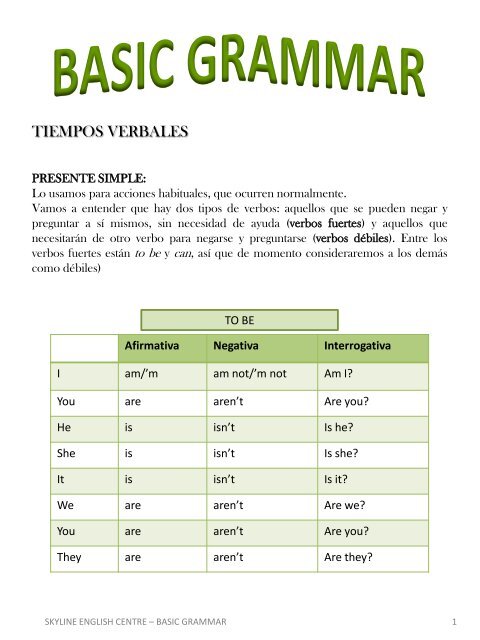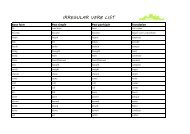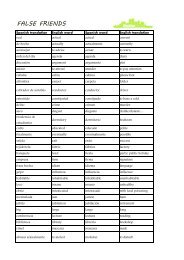basic grammar-gramatica basica - Skyline English Centre
basic grammar-gramatica basica - Skyline English Centre
basic grammar-gramatica basica - Skyline English Centre
You also want an ePaper? Increase the reach of your titles
YUMPU automatically turns print PDFs into web optimized ePapers that Google loves.
TIEMPOS VERBALES<br />
PRESENTE SIMPLE:<br />
Lo usamos para acciones habituales, que ocurren normalmente.<br />
Vamos a entender que hay dos tipos de verbos: aquellos que se pueden negar y<br />
preguntar a sí mismos, sin necesidad de ayuda (verbos fuertes) y aquellos que<br />
necesitarán de otro verbo para negarse y preguntarse (verbos débiles). Entre los<br />
verbos fuertes están to be y can, así que de momento consideraremos a los demás<br />
como débiles)<br />
TO BE<br />
Afirmativa Negativa Interrogativa<br />
I am/’m am not/’m not Am I?<br />
You are aren’t Are you?<br />
He is isn’t Is he?<br />
She is isn’t Is she?<br />
It is isn’t Is it?<br />
We are aren’t Are we?<br />
You are aren’t Are you?<br />
They are aren’t Are they?<br />
SKYLINE ENGLISH CENTRE – BASIC GRAMMAR 1
La ayuda que daremos a los verbos débiles será to do, el auxiliar, que llevará la carga<br />
de la negación, la interrogación y la tercera persona en los dos casos.<br />
TO DO<br />
Afirmativa Negativa Interrogativa<br />
I do don’t Do I?<br />
You do don’t Do you?<br />
He does doesn’t Does he?<br />
She does doesn’t Does she?<br />
It does doesn’t Does it?<br />
We do don’t Do we?<br />
You do don’t Do you?<br />
They do don’t Do they?<br />
DO<br />
Negación<br />
Interrogación<br />
3ª persona singular<br />
Los verbos débiles no tienen más conjugación que la adición de una –s en la 3ª<br />
persona del singular<br />
TO DO<br />
Afirmativa Negativa Interrogativa<br />
I play don’t play Do I play?<br />
You play don’t play Do you play?<br />
He plays doesn’t play Does he play?<br />
She plays doesn’t play Does she play?<br />
It plays doesn’t play Does it play?<br />
We play don’t play Do we play?<br />
You play don’t play Do you play?<br />
They play don’t play Do they play?<br />
SKYLINE ENGLISH CENTRE – BASIC GRAMMAR 2
TERCERA PERSONA DEL SINGULAR (he/she/it)<br />
1. Por regla general se añande al verbo una –s<br />
You think He thinks<br />
2. Si el verbo acaba en –s, -sh, -ch, -x, -z, -o añadimos –es<br />
You watch He watches<br />
You go He goes<br />
3. Si el verbo acaba en –y tenemos dos opciones<br />
Que acabe el vocal + y: añadimos –s<br />
You play He plays<br />
Que acabe en consonante + y: cambiamos la –y por –i y añadimos –es<br />
You study He studies<br />
ORDEN DE PALABRAS: el orden de palabras en inglés es muy estricto<br />
To be<br />
Verbos débiles<br />
Afirmativa S+ am/are/is+C S+V+C<br />
Negativa S+ am/are/is+ not+C S+AUX+NOT+V+C<br />
Interrogativa Am/are/is+S+C? AUX+S+V+C?<br />
SKYLINE ENGLISH CENTRE – BASIC GRAMMAR 3
PRESENTE CONTINUO:<br />
Lo usamos para:<br />
1. Hablar sobre algo que está pasando en el momento en el que hablamos<br />
I’m watching TV at the moment<br />
2. Expresar un futuro cercano y/o planificado<br />
I’m watching TV tonight<br />
Lo formamos con el verbo to be conjugado (am/are/is) y el verbo seguido de -ing<br />
Afirmativa<br />
Negativa<br />
Interrogativa<br />
Presente Continuo<br />
S+ am/are/is+V-ing+C<br />
S+ am/are/is+ not+V-ing+C<br />
Am/are/is+S+V-ing+C?<br />
CAN ( la 3ª persona del singular no varía)<br />
Tiene dos usos principales:<br />
1. Expresar una habilidad. Es el equivalente al español “saber”<br />
I can swim<br />
Sé nadar<br />
2. Expresar una posibilad. Es el equivalente al español “poder”<br />
Can I go home?<br />
¿Me puedo ir a casa?<br />
TO DO<br />
Afirmativa Negativa Interrogativa<br />
I can go can’t go Can I go?<br />
You can go can’t go Can you go<br />
He can go can’t go Can he go?<br />
She can go can’t go Can she go?<br />
It can go can’t go Can it go?<br />
We can go can’t go Can we go?<br />
You can go can’t go Can you go?<br />
They can go can’t go Can they go?<br />
SKYLINE ENGLISH CENTRE – BASIC GRAMMAR 4
PASADO SIMPLE:<br />
Lo usamos para acciones que sucedieron en el pasado.<br />
La conjugación en inglés es sencilla, siempre es la misma forma, no hay terceras<br />
personas del singular. Tenemos la misma división entre verbos fuertes y débiles<br />
como en el presente. Para formar la negación de los verbos débiles el auxiliar que<br />
utilizaremos será el pasado de to do: did.<br />
Ej. I don’t play football<br />
Do you play football?<br />
I didn’t play foorball<br />
Did you play football?<br />
Aparte de esta división existen dos tipos de verbos.<br />
I. Regulares: formamos el pasado añadiendo –ed<br />
Ej. Play- played<br />
II. Irregulares: son aquellos cuyas formas pasadas no siguen una regla (ver lista)<br />
Ej. Buy- bought<br />
Vimos la tele ayer<br />
A: We watched TV yesterday<br />
N: We didn’t watch TV yersterday<br />
I: Did we watch TV yesterday?<br />
TO BE - PASADO<br />
Afirmativa Negativa Interrogativa<br />
I was wasn’t Was I?<br />
You were weren’t Were you?<br />
He was wasn’t Was he?<br />
She was wasn’t Was she?<br />
It was wasn’t Was it?<br />
We were weren’t Were we?<br />
You were weren’t Were you?<br />
They were weren’t Were they?<br />
SKYLINE ENGLISH CENTRE – BASIC GRAMMAR 5
PREGUNTAS<br />
En inglés, como en español, hay dos clases de preguntas y las formamos de una<br />
manera muy similar:<br />
1. Preguntas cerradas (Yes/No questions): son aquellas cuya respuesta será sí o<br />
no. El orden de palabras es el siguiente<br />
Ej. Do you like pizza? Yes, I do/No, I don’t<br />
Are you Spanish? Yes, I am/No, I’m not<br />
2. Preguntas abiertas (open questions): son aquellas cuya respuesta puede ser<br />
cualquiera. Lo único que hay que hacer el poner la partícula interrogativa antes<br />
de la pregunta<br />
To be<br />
Ej. What do you want?<br />
Verbos débiles<br />
Interrogativa Am/are/is+S+C? AUX+S+V+C?<br />
To be<br />
Verbos débiles<br />
Interrogativa WH+am/are/is+S+C? WH+AUX+S+V+C?<br />
What Who Where When How Why<br />
Qué Quién Dónde Cuándo Cómo Por qué<br />
THERE IS / THERE ARE<br />
Estas expresiones se utilizan para expresar la cantidad de objetos o personas que se<br />
encuentran en un determinado lugar. Ambas formas significan “hay”. La primera se<br />
utiliza para el singular y la segunda para el plural. Para negar y preguntar utilizamos<br />
el verbo to be.<br />
There is a chair in the bedroom<br />
There are two chairs in the bedroom<br />
Hay una silla en el dormitorio<br />
Hay dos sillas en el dormitorio<br />
SKYLINE ENGLISH CENTRE – BASIC GRAMMAR 6
ADJETIVOS Y PRONOMBRES DEMOSTRATIVOS<br />
This Este/esta/esto These Estos/estas<br />
That Ese/ eso Those Esos/esas<br />
Cuando se utilizan como adjetivos, deben estar seguidos de un sustantivo<br />
This calculator is very good Esta calculadora es muy buena<br />
Cuando se utilizan como pronombres no están seguidos de sustantivos, dado que<br />
justamente los pronombres sirven para reemplazarlos.<br />
This is a calculator<br />
PLURAL<br />
Esto es una calculadora<br />
1) Por noma general se añade –s al sustantivo (recordad que los adjetivos no<br />
tienen plural en ingles-).<br />
Ej. One book Two books<br />
2) Si la palabra termina con –sh, -ch, -s, -x, -z, -o, añadimos –es<br />
Ej. One church – two churches<br />
One bus – two buses<br />
3) Si la palabra termina en –y tenemos dos opciones<br />
Que termine en vocal + y: añadiremos sólo –s<br />
Ej. One boy -- two boys<br />
Que termine en consonante+y: cambiaremos la –y por –i añadiendo –es<br />
Ej. One baby – two babies<br />
4) Cuando la palabra termina en –f/-fe, cambiaremos la –f por –v y añadimos –es<br />
Ej. One knife – two knives<br />
5) Hay pocas excepciones que normalmente no cambian en plural, como “fish” o<br />
“sheep” y los nombres incontables como “money”, “water”, “wine”…<br />
6) Tambien existen plurales irregulares:<br />
Child Woman Person Foot Mouse tooth<br />
Children Women people Feet Mice teeth<br />
SKYLINE ENGLISH CENTRE – BASIC GRAMMAR 7
A/AN/THE<br />
Usamos a/an para referirnos a algo indeterminado, siempre en singular. Es muy<br />
parecido al español “un/una”. Siempre acompañará a un nombre. Usamos a<br />
cuando la siguiente palabra empiece por consonante y an cuando la siguiente<br />
palabra empiece por vocal.<br />
Ej. A book<br />
An apple<br />
Usaremos the para referirnos a algo que ya conocemos o a algo específico.<br />
Ej. The car is blue<br />
Sirve tanto para singular como plural, pero no siempre que en español usemos<br />
“los/las” lo pondremos en inglés, sólo al referirnos a algo específico. Si hablamos de<br />
algo en general, lo omitimos.<br />
Ej. The dogs are brown (no todos los perros son marrones, sólo unos<br />
específicos)<br />
Dogs are brown (nos referimos a todos, en general)<br />
WOULD LIKE TO/WANT TO<br />
Son dos formas de decir lo que queremos. Want to es menos formal que Would<br />
like to y los dos funcionan prácticamente igual:<br />
Want to<br />
Would like to<br />
Afirmativa S+want/wants to+infinitivo+C S+would like to+infitivo+C<br />
Negativa S+aux+not+want to+infinitivo+C S+would like to+not+infitivo+C<br />
Interrogativa Aux+S+want to+infinitivo+C? Would+S+like to+infitivo+C?<br />
Ej. I want to travel<br />
I don’t want to travel<br />
Do you want to travel?<br />
I would like to read<br />
I wouldn’t like to read<br />
Would you like to read?<br />
¡Cuidado! Would funciona como auxiliar, así que no necesita ayuda para la<br />
negativa ni la interrogativa.<br />
SKYLINE ENGLISH CENTRE – BASIC GRAMMAR 8
PREPOSICIONES<br />
IN: lo usamos para períodos de tiempo largos y para situar algo “dentro de” algún<br />
sitio. Lo usamos para meses, años, estaciones, siglos… y partes del día (¡Cuidado! At<br />
night es una excepción)<br />
Ej. In February<br />
In the moning<br />
In the classroom<br />
In the afternoon<br />
In 1999<br />
In the evening<br />
ON: lo usamos para hablar de períodos algo más cortos de tiempo y para situar algo<br />
“sobre” algún sitio. Lo usamos para días específicos y fechas<br />
Ej. On Tuesday<br />
On Tuesday evening<br />
The pencil is on the table On 2nd September<br />
AT: lo usamos para hablar de momentos o lugares específicos. Lo usamos con<br />
horas, direcciones y cuando el lugar incluye el genitivo sajón.<br />
Ej. At four o’clock<br />
At night<br />
At 213 Oxford street*<br />
At the weekend<br />
*¡Cuidado! Cuando hablamos de la calle, usamos in pero si incluimos el número<br />
usaremos at.<br />
UNDER: significa “debajo de”<br />
NEXT TO: significa “al lado de”<br />
BETWEEN: significa “entre”<br />
DIRECCIONES<br />
Para dar direcciones tenemos que tener en cuenta ciertas expresiones:<br />
Go straight on<br />
Turn right<br />
Turn left<br />
On your right<br />
On your left<br />
Pass<br />
Cross<br />
sigue todo recto<br />
gira a la derecha<br />
gira a la izquierda<br />
a tu derecha<br />
a tu izquierda<br />
pasa<br />
cruza<br />
Ej. Go straight on, turn right on the first street, pass Oxford Street and it is the first<br />
building on your right<br />
SKYLINE ENGLISH CENTRE – BASIC GRAMMAR 9
HORAS<br />
Para preguntar por la hora utilizamos What’s the time? o What time is it?<br />
Para expresar la hora tenemos frases fijas:<br />
It’s four o’clock 4.00<br />
It’s half past four 4.30<br />
It’s a quarter past four 4.15<br />
It’s a quarter to four 3.55<br />
It’s twenty past four 4.20<br />
to past<br />
It’s twenty to four 3.40<br />
Pronombres<br />
sujeto<br />
Pronombres<br />
objeto<br />
Adjetivos<br />
posesivos<br />
I Me My Mine<br />
You You Your Yours<br />
He Him His His<br />
She Her Her Hers<br />
It It Its Its<br />
We Us Our Ours<br />
You You Your Yours<br />
They Them Their Theirs<br />
Pronombres<br />
posesivos<br />
Pronombres sujeto: sólo funcionan como sujeto y van seguidos del verbo<br />
You speak <strong>English</strong><br />
Pronombres objeto: funcionan como objeto derecto e indirecto<br />
My sister writes a letter<br />
My sister writes it<br />
I saw your brother<br />
I saw him<br />
Adjetivos posesivos: siempre acompañan al nombre y lo traducimos como “mi, tu,<br />
su”<br />
My brother<br />
Your book<br />
Pronombres posesivos: sustituyen al nombre, lo traducimos como “mío, tuyo…”<br />
The book is mine<br />
Yours is red<br />
SKYLINE ENGLISH CENTRE – BASIC GRAMMAR 10
VERBOS MAS COMUNES<br />
Buy<br />
Close<br />
Cook<br />
Do<br />
Drink<br />
Drive<br />
Eat<br />
Get<br />
Go<br />
Listen to<br />
Live<br />
Open<br />
Play<br />
Read<br />
Run<br />
See<br />
Sleep<br />
Speak<br />
Start<br />
Stop<br />
Teach<br />
Walk<br />
Watch<br />
Wear<br />
Work<br />
Write<br />
comprar<br />
cerrar<br />
cocinar<br />
hacer<br />
beber<br />
conducir<br />
comer<br />
conseguir<br />
ir<br />
escuchar<br />
vivir<br />
abrir<br />
jugar<br />
leer<br />
correr<br />
ver<br />
dormir<br />
hablar<br />
empezar<br />
parar<br />
enseñar<br />
andar<br />
mirar<br />
llevar puesto<br />
trabajar<br />
escribir<br />
SKYLINE ENGLISH CENTRE – BASIC GRAMMAR 11
DAYS<br />
Monday<br />
Tuesday<br />
Wednesday<br />
Thursday<br />
Friday<br />
Saturday<br />
Sunday<br />
MONTHS<br />
January<br />
February<br />
March<br />
April<br />
May<br />
June<br />
July<br />
August<br />
September<br />
October<br />
November<br />
December<br />
1 one 1st first<br />
2 two 2nd second<br />
3 three 3rd third<br />
4 four 4th fourth<br />
5 five 5th fifth<br />
6 six 6th sixth<br />
7 seven 7th seventh<br />
8 eight 8th eighth<br />
9 nine 9th ninth<br />
10 ten 10th tenth<br />
11 eleven 11th eleventh<br />
12 twelve 12th twelfth<br />
13 thirteen 13th thirteenth<br />
14 fourteen 14th fourteenth<br />
20 twenty 20th twentieth<br />
21 twenty-one 21st twenty-first<br />
30 thirty 30th thirtieth<br />
SKYLINE ENGLISH CENTRE – BASIC GRAMMAR 12
Parts of the House<br />
House<br />
Kitchen<br />
Living-room<br />
Dining-room<br />
Bathroom<br />
Bedroom<br />
Room<br />
Garden<br />
Kitchen<br />
Oven<br />
Microwave<br />
Cooker<br />
Cupboard<br />
Dishwasher<br />
Washing-machine<br />
Sink<br />
Fridge<br />
Freezer<br />
Fork<br />
Knife<br />
Spoon<br />
Glass<br />
Dish<br />
Bedroom<br />
Bed<br />
Night table<br />
Wardrobe<br />
Chair<br />
Desk<br />
Lamp<br />
Computer<br />
VOCABULARY<br />
casa<br />
cocina<br />
salón<br />
comedor<br />
baño<br />
dormitorio<br />
habitación<br />
jardín<br />
horno<br />
microondas<br />
cocina (el fuego)<br />
armario<br />
lavavajillas<br />
lavadora<br />
fregadero<br />
frigorífico<br />
congelador<br />
tenedor<br />
cuchillo<br />
cuchara<br />
vaso<br />
plato<br />
cama<br />
mesilla<br />
armario<br />
silla<br />
mesa de estudio<br />
lámpara<br />
ordenador<br />
SKYLINE ENGLISH CENTRE – BASIC GRAMMAR 13
Living-Room/Dining-Room<br />
Table<br />
mesa<br />
Sofa<br />
sofá<br />
Armchair<br />
sillón<br />
DVD player<br />
reproductor de DVD<br />
Stereo<br />
equipo de música<br />
Window<br />
ventana<br />
Television/TV televisión<br />
Carpet<br />
alfombra<br />
Telephone<br />
teléfono<br />
Bathroom<br />
Bathtub<br />
Shower<br />
Sink<br />
Mirror<br />
Toilet<br />
Jobs<br />
Doctor<br />
Nurse<br />
Teacher<br />
Businessman<br />
Actor<br />
Actress<br />
Journalist<br />
Waiter<br />
Clothes<br />
Trousers<br />
Dress<br />
Skirt<br />
Shoes<br />
Trainers<br />
Boots<br />
Suit<br />
bañera<br />
ducha<br />
lavabo<br />
espejo<br />
sanitario<br />
médico<br />
enfermera<br />
profesor<br />
hombre de negocios<br />
actor<br />
actriz<br />
periodista<br />
camarero<br />
pantalones<br />
vestido<br />
falda<br />
zapatos<br />
zapatillas de deporte<br />
botas<br />
traje<br />
SKYLINE ENGLISH CENTRE – BASIC GRAMMAR 14
Parts of the Body<br />
Body<br />
Head<br />
Hair<br />
Eye<br />
Nose<br />
Mouth<br />
Arm<br />
Hand<br />
Leg<br />
Foot<br />
Family<br />
Family<br />
Father<br />
Mother<br />
Parents<br />
Son<br />
Daughter<br />
Sister<br />
Brother<br />
Granmother<br />
Grandfather<br />
Uncle<br />
Aunt<br />
Cousin<br />
cuerpo<br />
cabeza<br />
pelo<br />
ojo<br />
nariz<br />
boca<br />
brazo<br />
mano<br />
pierna<br />
pie<br />
familia<br />
padre<br />
madre<br />
padres<br />
hijo<br />
hija<br />
hermana<br />
hermano<br />
abuela<br />
abuelo<br />
tío<br />
tía<br />
primo/a<br />
SKYLINE ENGLISH CENTRE – BASIC GRAMMAR 15




